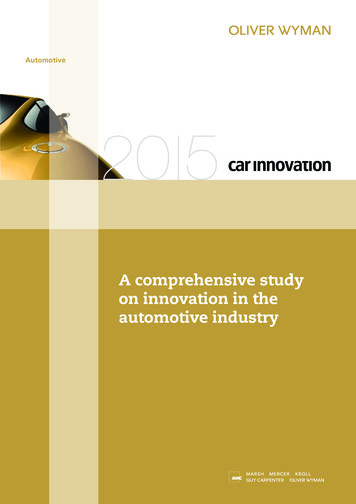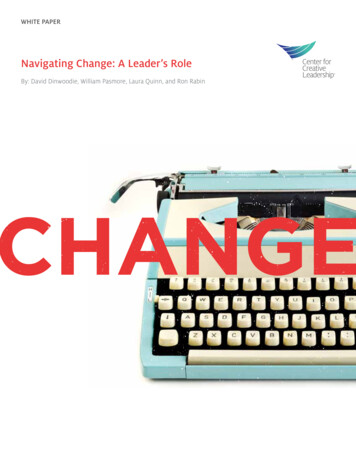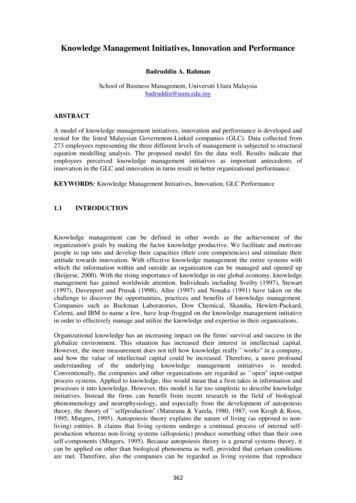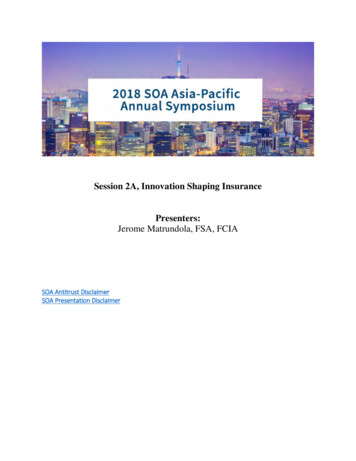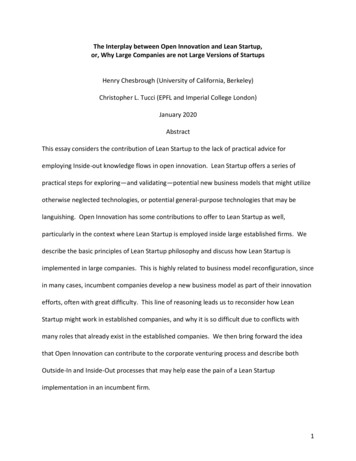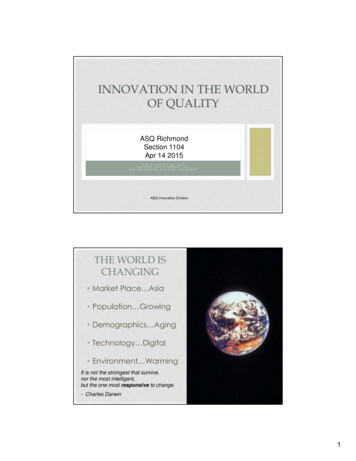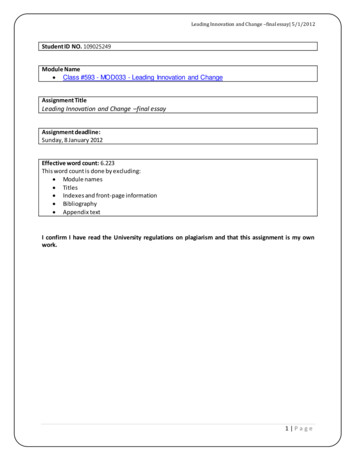
Transcription
Leading Innovation and Change –final essay 5/1/2012Student ID NO. 109025249Module Name Class #593 - MOD033 - Leading Innovation and ChangeAssignment TitleLeading Innovation and Change –final essayAssignment deadline:Sunday, 8 January 2012Effective word count: 6.223This word count is done by excluding: Module names Titles Indexes and front-page information Bibliography Appendix textI confirm I have read the University regulations on plagiarism and that this assignment is my ownwork.1 P age
Leading Innovation and Change –final essay 5/1/2012ContentsUnderstanding Innovation and change.4Innovation, Creativity and Invention .4Innovation .4Creativity .5Change .5Incremental changes .5Revolutionary changes.5Reactive and anticipatory changes.5Hard and soft changes .6Theory O and E.6Leading Change .6Role of the leader.6Change models.7Lack in the models of change .7Analyze change needed .8Leadership Style .8Relating styles.8Winning support for change.9Recognizing the need for change .9Analyzing change required . 10Skills of leaders of Change. 11Change to systems and processes. 11Successful change. 12Successful and Unsuccessful Change . 13The Successful Innovation and Change . 13What played a role in the success? . 13The Not Successful Innovation and Change. 14What played a role in the failure?. 14Reflection and Introspection . 15Personal Performance as a Leader of Innovation and Change . 15Action plan to improve Leading Innovation. 152 P age
Leading Innovation and Change –final essay 5/1/2012Bibliography. 17Apendix A. 19Table 1 . 193 P age
Leading Innovation and Change –final essay 5/1/2012Understanding Innovation and changeInnovation, Creativity and InventionInnovationOrganizations are changing their view on the definition of change. Innovation is i ncreasingly seen assomething that can help organizations work in new ways, enter new categories or channels and producenew products and services. This view on innovation makes the active and creative role of innovationvery clear (Isaksen and Tidd, 2006). Innovation can be seen as the capacity to change that can helporganizations define new things on different fronts. This capacity will only change reality though, whenit enters the active phase of applicability.Innovation can be called the capacity to change. Innovation without change has no true meaning for anorganization. It would be innovation without a result (Carnall, 2007). Although innovation involveschanges, not every change involves innovation (Boak, 2010). Innovation has to leave the theoreticalphase to make change occur.Process innovation is the challenge of using often scarce resources more effectively or becoming fasterand more flexible in their response to a diverse environment. Product innovation is about usingcombinations of new and existing knowledge to deliver new or improved ‘product concepts’.Discontinuous innovation is comparable with disruptive innovation in that it interrupts the normal wayof doing things (Isaksen and Tidd, 2006). Opposite to disruptive innovation is routine innovation that isfound where the market is familiar with the product class but the technology is new (Meyers and Tucker,1989).These different kinds of innovations all demand a different approach and use of it. Disruptiveinnovation should be managed differently from routine innovation. They demand different resourcesand organization. The most benefit for organizations comes from a combination of process and productinnovation. This is when the innovation of products is done within optimized and innovative processes(Isaksen and Tidd, 2006).Continuous improvement can be an element of organizational innovation. The delicate balance betweenrisk and stability is important within organizational innovation. A key factor to organizational innovationis having a clear image of the desired results, a clear vision and a stable strategy and product innovationcharter (Holbeche, 2006).Incremental, safe and widespread innovation may be better for internal considerations. This can oftenbe related to small changes. Novel and disruptive innovations may be better for market considerations(Isaksen and Tidd, 2006). When the business strategy is not well aligned to these different kinds ofinnovation, failure is almost unavoidable.4 P age
Leading Innovation and Change –final essay 5/1/2012CreativityCreativity has to do with coming up and expressing new ideas and perspectives. Creativity stands forcreating outside the normal rules of convention or defined boundaries (Mackay, 2010). Besides artisticcreativity there is business creativity. Business creativity can by definition be described as a pragmaticart. It creates environments in which innovative ideas can emerge. Creativity can be related withbreaking rules, but it is not about breaking the business (Hall, 2010).Due to these different aspects of creativity it is important to give it a rightful place within theorganization. It needs to be placed within well-defined boundaries to be useful and safe. Creativitywithin organizations should be encouraged to make innovation happen. Leaders within organizationshave an important role in the process of encouraging creativity. It is their attitude, personal qualities andskills that can make a difference (Adair, 2007).Not all new ideas coming from inventive thinking are actually developed. In order for the ideas to berealized and put to work, the process of innovation has to occur. Inventing as a process of being creativeis a passive process in the sense that it does not produce something on itself. Invention needs the activeprocess of innovation to eventually be productive (Adair, 2007).ChangeWhatever their sector, today’s organizations are operating in a fast-changing marketplace. Change iseverywhere (Holbeche, 2006). Change happens at different paces and at different levels. Changeinvolves dissolving existing patterns of behavior, establishing new behaviors and making them the norm(Hayes, 2010).Incremental changesThere are ‘varieties of change’. The first is ‘smooth incremental change’ which is change that evolvesslowly in a systematic and predictable way. The second is ‘bumpy incremental change’ which ischaracterized by periods of relative tranquility punctuated by acceleration in the pace of change. Thethird is ‘discontinuous change’ which is defined as marked by rapid shifts in strategy, structure or cultureor in all three (Senior and Fleming, 2006).Revolutionary changesRevolutionary changes tend to be more radical. Revolutionary changes are also known as framebreaking because they usually make huge changes in existing structures. Transformational change ishighly a political process that threatens different interest groups and is characterized by conflict. Thesechanges have a radical character and are discontinuous in nature (Senior and Fleming, 2006).Reactive and anticipatory changesReactive and anticipatory changes are changes that are made in direct response to some external event.Anticipatory changes can occur when organizations believe that change and anticipation of events stillto come will generate greater competitive advantage (Dive, 2004). Planned change is a deliberate,intentional change. They take place in the form of improvement projects, such as development of a newproduct, purchase of new equipment or reorganization of formal structure (Yukl, 2002 and 2006).5 P age
Leading Innovation and Change –final essay 5/1/2012Hard and soft changesHard changes concerns technical issues that can be analyzed to produce the right answer for the change.Soft changes are more complex because they tend to have more possible viewpoints. Hard changes suchas corporate structure and systems should be carried out, while making ‘soft’ changes to the dynamic ofthe corporate workplace and its culture (Senior and Fleming, 2006).Organizational development practitioners are increasingly working with organizations to facilitatesystem-wide planned change processes (Holbeche, 2006). These change processes are products ofconscious reasoning and actions (Iles and Sutherland, 2001). Successful organizational transformationand managing change demand both leadership and management as well as creativity and innovation(Isaksen and Tidd, 2006).Theory O and ETwo theories about change are Theory O and Theory E type of changes. Theory E has a focus onincreasing shareholder value in the short run and Theory O change initiatives focus on transformingorganizational culture. In practice Theory O is often more difficult to predict and less exact in naturethen Theory E changes (Essentials, 2005).Theory O is change based on organizational capabilities and can be related to the Soft changes. The goalis to develop corporate culture and human capability through individual and organizational learning(Holbeche, 2006). Theory O aims at incremental performance improvement through incrementalchanges to the organizational culture, capability and the promotion of organizational learning.Theory E change pursues the maximization of shareholder value through financial incentives, downsizingand divestment. It is about tough choices driven by financial imperatives and financial performance(Carnall, 2007). These types of changes are often characterized as revolutionary or hard changes. It canalso be related to structured and planned changes (Boak, 2010). When setting goals, an organizationshould embrace the paradox between economic value (Type E) and organizational capabilities (Type O).Leading ChangeRole of the leaderLeadership is the process of influencing others to understand and agree what needs to be done and howit can be done effectively. It is the process of facilitating individual and collective efforts to accomplishthe shared objectives. How effective the leader is depends in part on how the game is played to resolverole conflicts, cope with demands, recognize opportunities and overcome constraints (Yukl, 2002 and2006).New ways of leadership styles and skills are needed for future organizations. There are two broadconceptions of what leaders do – they motivate their followers and they design organizational contextto enable their followers to function effectively (Munshi, 2005).In the future hierarchical management structures will be less evident. Management of intellectualcapital will require skills that nurture creativity and innovation in workforces rather than compliance in6 P age
Leading Innovation and Change –final essay 5/1/2012the past. Regimes of control and command will no longer suffice. In a world of outsourcing and contractworking, managers will need skills to plan and coordinate ‘associates’, who are working in different partsof the world (Senior and Fleming, 2006).Change modelsChange is about working together. It is unwise to act alone as a leader. Putting more executives at thetop does not work either. It is better to build a coalition of people who have position power, expertise,credibility and leadership. The members of this “guiding coalition” need management and leadershipqualities to make it work (Kotter, 1996).There are two important models of change. The five staged model of Hayes (2010) and the eight stepmodel of Kotter (1996). They see change as a process that goes through a series of stages. Their stepsgive us a guideline for handling change within organizations. Hayes talks about people management asan overall process guiding his steps. Kotter talks about the guiding coalition, the supporting team.One of the elements of the people management of Hayes is communicating the change and this isstrongly related to the communication of the vision in the steps of Kotter. Hayes talks about motivatingothers to change and this is what the guiding coalition of Kotter is all about. Hayes emphazise peoplemanagement and place it as an umbrella over the steps, but the steps themselves are quite analytical. Itwould be better when the people part was integrated in the steps in the first place. That is where thesteps of Kotter (1996) are stronger.Lack in the models of changeThe model of Kotter (1996) does miss some important apects.The steps suggest that the need forchange and the expected change are already known. This is not always the case. The model of Hayes(2010) does take this into account and address the issue of choosing the change to follow afterrecognizing the need for it. Sometimes the stage models are an over-simplification of the situation.Change processes in reality are messy and untidy, unfolding in an iterative fashion (Buchanan and Storey,1997).What appears to be cause and effect may actually be ‘coincidental’ symptoms (Carnall, 2007). Anyorganization is a balance of forces built up and refined over a period of time (Senior and Fleming, 2006).Consequently, proposed change of any significance will inevitably change this balance. Stage modelsoften do not take these interwoven processes and relations of changes into account and are not usefulfor every change situation.It is not allways clear if all changes follow the stages of Kotter (1996) or Hayes (2010) for that matter.Different kind of opposition is also missing, for example the ‘nay sayers’. Kotter (1996) s eems to talkabout the visionary leadership style while there are other forms of leadership and maybe the model isdifficult to use with other styles. Leadership is not the only succesfactor of change and other elementsof succes are difficult to find in the stage models (Boak, 2010).7 P age
Leading Innovation and Change –final essay 5/1/2012Analyze change neededIt is important to first analyze which kind of change is needed. The stage models of Kotter (1996) andHayes (2010) are based on a typical kind of leadership. The opposite is that it can be advantageous tostart with an analyzing phase. Not all changes are worth the time and effort. Therefore the feasibility ofthe planned change should be analyzed (Isaksen and Tidd, 2006) .When analyzing the change needed it is important to know how the organization handled change in thepast or what the current changes are the organization faces. What kind of resources are needed for thechange or how is the power devided when taking action are valuable questions. Analyzing the neededchange before implementing or choosing a model for the implementation is important (Isaksen and Tidd,2006).Leadership StyleLeadership styles have a great influence on how the change is handled and indi rectly how successful thechange process will be. Three main leadership styles are important; autocratic, consultative and grouporiented. These three styles can yield different levels of effectiveness based on the three criteria ofquality of solution, time required to arrive at it and acceptance of it by subordinates (Isaksen and Tidd,2006).Another popular leadership model is an outwardly practical approach to Situational Leadership. The‘readiness’ of followers is a key factor in deciding on an appropriate leadership style. The leader’s taskbehavior (providing guidance and direction) and relationship behavior (team building, providing socioemotional support) should accord with the readiness of followers (Carnall, 2007). This is definitely amore human oriented approach to leading change then the stage models described earlier (Hayes,2010).Relating stylesTheory E type of change has different leadership needs then the Theory O type of change. A top down,directive and coercive type of change is needed for Type E, which can be related to the more autocratictype of leadership. A participative, empowering and facilitative type of leadership is needed for TheoryO type of change (Isaksen and Tidd, 2006).Hard system changes concern the less complex changes which can be handled by effective analysis,planning and implementation. Soft system changes concern the more complex changes which requiremore participative approaches and a greater engagement in managing the views and expectations ofthese stakeholders (Boak, 2010).There is a clear relationship between both the Theory E and Theory O Type of changes and the hard andsoft system change. The Theory O Type of change can be related to the soft system changes becausethey both need a more participative, empowering and facilitative type of leadership and are morecomplex in nature then Theory E type of changes or the hard system changes (Boak, 2010).Theory E type of changes can be related to the hard system type of changes that are more direct ofnature and are a more top down, directive and coercive type of change which need a more autocratic8 P age
Leading Innovation and Change –final essay 5/1/2012and hierarchical type of leadership. Theory E and O Type of changes are often related to organizationalwide changes and the hard and soft system changes are related to smaller types of change (Boak, 2010).Winning support for changeWinning support for change from stakeholders is important. For the adaptive, the supportive Theory OType of change or the soft system changes, it is important to identify the key stakeholders. Once newconcepts and ideas are developed, the next logical focus of attention is to prepare them for themarketplace and acceptance from key stakeholders (Isaksen and Tidd, 2006).Important changes can be blocked by key stakeholders (Carnall, 2007). It is imperative to identify thosekey stakeholders to formulate a plan to get those stakeholders on board of acceptance. Identifystakeholders who will be affected by the change to neutralize or persuade those who could block it, andmobilize those with the power to make it happen (Hayes, 2010).One way to identify key stakeholders is to map them in a matrix. Key stakeholders may includeowners, executives, other members of the organization, customers, investors, joint venture partners,and labor unions. They all play their role and have different kinds of interests and influence on thechange. Stakeholders can be internal and external (Yukl, 2002 and 2006).It is important to get an insight on the power and interest of the stakeholders. Stakeholders can have apositive, neutral or negative interest in the change. Stakeholders differ in terms of their power.Managers may pay careful attention to some powerful stakeholders but they may completely overlookothers (Hayes, 2010).To make the change really successful, you have to align the change to as many stakeholders as possible.Proper stakeholder analysis in relation to the change is needed. Effective collaboration ofemployees/stakeholders is more likely if they are involved at all stages of the change process and notjust its implementation (Senior and Fleming, 2006). Constantly analyze the state of the change and therole of the stakeholders during that specific state. Stakeholder analysis must be an ongoing process tobe really successful.The individual attitudes of key stakeholders should be assessed (or guessed at). Their communicationpreferences should be identified if possible. What are their formal and informal networks? What aretheir emotional needs, such as whether they would prefer to be involved, how they like to be ‘handled’?All these aspects should be identified, along with any known personal agendas that might indicate thatone type of communication may work better than another (Holbeche, 2006).Recognizing the need for changeBefore change can happen the need for change must be recognized. This stage can be related to theUnfreezing part of the three-stage model of change from Lewin (1947). In the unfreezing stage thepeople involved come to recognize that something must change. This is something else thenimplementing the change. It is important to know how ready the individuals, teams and organizationare to take on the needed changes (Isaksen and Tidd, 2006). If they are not ready to accept thechanges, then it is important to first create a sense of urgency for the needed change (Kotter, 1996).9 P age
Leading Innovation and Change –final essay 5/1/2012There are factors that can help to indicate that change is needed. Regular interview may reveal a needto change. It can discover what behaviors to unfreeze or unlock. Identify unproductive current behaviorand try to lift up the organization to a new level and then refreeze the new situation and behavior. Beaware of external forces and limits when evaluating your organizations need for change (Hayes, 2010).One of the pitfalls of the trap of success is turning the focus inside the organization and forgetting thedynamic changing world outside the organization. Analyze the stage where your organization is in now(Kotter, 1996). Monitoring the environment is important to keep informed of competitors’ activities,new legislation, change in the market and other factors. Fail to do so make the risk of missing the needfor change higher (Mintzberg, 1980).Needed change can still stall because of inwardly focused cultures, paralyzing bureaucracy, parochialpolitics, a low level of trust, lack of teamwork, arrogant attitudes, a lack of leadership in middlemanagement, and the general human fear of the unknown. To be effective, a method designed to al terstrategies, reengineer processes, or improve quality must address these barriers and address them well(Kotter, 1996).People may fail to recognize the need for change because they were excluded from relevant discussion,were too busy with other things or were simply resistant to the notion of change for all kind of personalreasons. Often the latter happens when the change might threaten their own power base (Holbeche,2006).Management support is essential to innovation and change. But despite this support many blockingelements can occure. Some of these blocking elements can be divided into several areas. They are perceptual blocks, we see what we want to see, - emotional blocks, our emotions dictated our reality, cultural block, our culture learned us what we believe, - environmental blocks, something in ourenvironment is blocking the change, and the cognitive blocks, when we do not try to see past the thingswe know the learning and change process will be seriously delayed (Carnall, 2007).Single-loop learning can be used as a means of monitoring the performance of organizational systemsand subsystems in relation to the objectives set for them (Senior and Fleming, 2006). If an organizationfell into the trap of success then single-loop learning will be done without the needed view on theenvironment in which these systems must compete (Nadler, Shaw and Walton, 1994). Monitoring andevaluation are important means of following through with change seeking further improvement. Whenan organization does not monitor the right values, it risks missing important moments of change (Carnall,2007).Analyzing change requiredBefore choosing the type of change to implement, it is important to first analyze which type of change isneeded. Often the first, quick-fix solutions are rarely the right ones. The cure can become worse thanthe disease. Repeated problems are often signs that the real solutions have not been found (Boak, 2010).Reviewing the present state can help identify the required change by diagnosing the cause of theproblem, identify current deficiencies or clarify opportunities. It can also help establish a baseline so10 P a g e
Leading Innovation and Change –final essay 5/1/2012that it is clear what is changing and will be changed in the future and it can help define the futuredirection.Although it depends on the kind of change needed to identify the future state, it can be of help todisconfirm the view of the people involved that all is well with the existing state of affairs and create asense of urgency which could lead to recognizing the need to change (Kotter, 1996). It can also be ofhelp to make a gap analysis between the current and future state which can be of help to identify theneeded type of change to make the future state a reality.If the required change is very complex and difficult to communicate, the initial style of influence mightinvolve a high level of explanation and education. Once people understand the problem and what isrequired, other means of influence might be more effective. Similarly, a change that is compatible withthe change target preferences and offers relative advantage over current practice might lend itself to apersuasive strategy. In other cases negotiation or high levels of involvement might be the most effectiveway forward. Where the change is divisible and where quick action is required i t might be decided todirect a part of the organization to adopt a small-scale trial before making a decision about how toproceed (Hayes, 2010).Skills of leaders of ChangeThere are three things a leaders should be good at. The first is business competence. They must knowthe business, its complexities and must stay on top of it. The second is personal effectiveness. They mustkeep themselves in shape with mind, body and spirit. The third is relationships; they must be good in theneeded politics and invest in stakeholder relationships (Holbeche, 2006).Different type of change and different context may require different styles and skills of leadership.Theory E Type of change for example demands a different kind of leader than a Theory O Type of change.Hard system changes prosper well in hierarchical organizations but this is not the case for soft systemchange. Incremental changes need a more managerial type of leadership where the bumpy changes, t hemore radical changes need more than just a managerial type of leadership (Boak, 2010).There has been little research on the relative advantage of training, development and self-help activitiesfor different types of leadership skills. Likewise, little is known about the best way to combine training,development, and self-help activities to maximize their mutual effects. There is need for a moresystematic approach to the study of leadership development activities (Yukl, 2002 and 2006).Change to systems and processesChange has to do with altering systems and processes. There are several ways to make changes. Twolargely dominant ways to treat changes are Total Quality Management (TQM) and Business Process ReEngineering (BPR), which involves process Improvements.TQM is an organization-wide, long-term change effort designed to orient all of an organization’sactivities ar
Leading Change Role of the leader Leadership is the process of influencing others to understand and agree what needs to be done and how it can be done effectively. It is the process of facilitating individual and collective efforts to accomplish the shared objectives. How effective the leade


